High Performance Concretes with Highly Reactive Rice Husk Ash and Silica Fume
Abstract
1. Introduction
2. Materials and Methods
2.1. Cementitious Materials
2.2. Aggregates
2.3. Superplasticizer
2.4. Fibers
2.5. Mixture Proportions
2.5.1. Cementitious Pastes
2.5.2. Concrete Mixtures
2.6. Mixing and Casting Procedures
2.7. Testing of Concrete Samples
3. Results
3.1. Effect of SCM’s on the Hydration of Cement Pastes
Porosity of the Cementitious Pastes
3.2. Effect of SCMs on Simple and Fiber-Reinforced Concrete Mixes
3.2.1. Workability
3.2.2. Compressive Strength
3.2.3. Elastic Modulus
3.2.4. Flexural Strength
3.2.5. Flexural Toughness
3.2.6. Durability Tests
Chloride Ion Permeability
Carbonation Tests
4. Discussion
5. Conclusions
- THRA is a highly reactive pozzolanic material that, when added to concrete mixes, produces superior results in both strength and durability.
- The pozzolanic reactions that occur with the incorporation of RHA in cementitious mixtures generate denser hydration products (CSH gel) that eliminate most of the capillary porosity, causing the formation of finer pores, resulting in a refinement of the porous network of the material, reducing its permeability and increasing its strength and durability properties.
- The increase in compressive strength of the mixes with TRHA is more pronounced at short ages, with values higher than 20% of the strength obtained with the control mix. This high initial reactivity is due to the high specific surface area and the higher purity of silica in the ash. At higher ages, the increase in strength is comparable to that caused by SF, with percentage values 12% higher than the strength of the control mix.
- The incorporation of RHA increased flexural strength even more significantly. The flexural strength of concrete with RHA, TRHA, and SF increased by 20%, 46%, and 36%, respectively.
- The incorporation of polyethylene–polypropylene fibers into the HPC mixtures does not significantly affect the values of compressive strength and modulus of elasticity of the concrete mixtures. However, for the flexural strength, it increases up to 50% for the mixture with TRHA compared to the strength of plain concrete and is of the order of 28% for the mixture with RHA and 41% for the mixture with SF.
- The results of the chloride ion penetration and carbonation test were negatively affected by the addition of polyethylene–polypropylene fibers due to the higher porosity in the interface between polymeric fiber and cement paste.
- Despite TRHA is a material with pozzolanic properties that is identical to SF, it is necessary to perform further research to demonstrate its effectiveness under different environmental conditions. Such activity is important because this agricultural waste is abundantly available in several countries of the planet.
Author Contributions
Funding
Institutional Review Board Statement
Informed Consent Statement
Data Availability Statement
Acknowledgments
Conflicts of Interest
References
- Janowska-Renkas, E.; Jakiel, P.; Fabianowski, D.; Matyjaszczyk, D. Optimal selection of high-performance concrete for post-tensioned girder bridge using advanced hybrid MCDA method. Materials 2021, 14, 6553. [Google Scholar] [CrossRef] [PubMed]
- Neville, A.; Aitcin, P.C. High performance concrete—An overview. Mater. Struct. 1998, 31, 111–117. [Google Scholar] [CrossRef]
- Dushimimana, A.; Niyonsenga, A.A.; Nzamurambaho, F. A review on strength development of high performance concrete. Const. Buil. Mater. 2021, 307, 124865. [Google Scholar] [CrossRef]
- Walraven, J. High Performance Concrete: A Material with a Large Potential. J. Adv. Concr. Technol. 2009, 7, 145–156. [Google Scholar] [CrossRef]
- Salas-Montoya, A.; Mira-Rada, B.E. Evaluation of key aggregate parameters on the properties of ordinary and high strength concretes. VITRUVIO-Inter. J. Archi. Technol. Sustain. 2023, 8, 76–85. [Google Scholar]
- Beskopylny, A.N.; Shcherban, E.M.; Stelmakh, S.A.; Meskhi, B.; Shilov, A.A.; Varavka, V.; Evtushenko, A.; Özkılıç, Y.O.; Aksoylu, C.; Karalar, M. Composition Component Influence on Concrete Properties with the Additive of Rubber Tree Seed Shells. Appl. Sci. 2022, 12, 11744. [Google Scholar] [CrossRef]
- John, V.M.; Damineli, B.L.; Quattrone, M.; Pileggi, R.G. Fillers in cementitious materials-Experience, recent advances and future potential. Cem. Con. Res. 2018, 114, 65–78. [Google Scholar] [CrossRef]
- Li, L.G.; Ng, P.-L.; Zeng, K.-L.; Xie, H.-Z.; Cheng, C.-M.; Kwan, A.K.-H. Experimental Study and Modelling of Fresh Behaviours of Basalt Fibre-Reinforced Mortar Based on Average Water Film Thickness and Fibre Factor. Materials 2023, 16, 2137. [Google Scholar] [CrossRef]
- Rodrigues, A.L.M.V.; Mendes, Á.Á.F.; Gomes, V.; Battagin, A.F.; Saade, M.R.M.; Da Silva, M.G. Environmental and Mechanical Evaluation of Blended Cements with High Mineral Admixture Content. Front. Mater. 2022, 9, 880986. [Google Scholar] [CrossRef]
- Karalar, M.; Bilir, T.; Çavuşlu, M.; Özkiliç, Y.O.; Sabri, M.M.S. Use of recycled coal bottom ash in reinforced concrete beams as replacement for aggregate. Front. Mater. 2022, 9, 1064604. [Google Scholar] [CrossRef]
- Qaidi, S.; Najm, H.M.; Abed, S.M.; Özkılıç, Y.O.; Al Dughaishi, H.; Alosta, M.; Sabri, M.M.S.; Alkhatib, F.; Milad, A. Concrete Containing Waste Glass as an Environmentally Friendly Aggregate: A Review on Fresh and Mechanical Characteristics. Materials 2022, 15, 6222. [Google Scholar] [CrossRef]
- Çelik, A.İ.; Özkılıç, Y.O.; Zeybek, Ö.; Karalar, M.; Qaidi, S.; Ahmad, J.; Burduhos-Nergis, D.D.; Bejinariu, C. Mechanical Behavior of Crushed Waste Glass as Replacement of Aggregates. Materials 2022, 15, 8093. [Google Scholar] [CrossRef]
- Karalar, M.; Özkılıç, Y.O.; Aksoylu, C.; Sabri, M.M.S.; Beskopylny, A.N.; Stelmakh, S.A.; Shcherban, E.M. Flexural behavior of reinforced concrete beams using waste marble powder towards ap-plication of sustainable concrete. Front. Mater. 2022, 9, 1068791. [Google Scholar] [CrossRef]
- Acar, M.C.; Çelik, A.İ.; Kayabaşı, R.; Şener, A.; Özdöner, N.; Özkılıç, Y.O. Production of per-lite-based-aerated geopolymer using hydrogen peroxide as eco-friendly material for energy-efficient buildings. J. Mater. Res. Technol. 2023, 24, 81–99. [Google Scholar] [CrossRef]
- Çelik, A.; Özkılıç, Y. Geopolymer concrete with high strength, workability and setting time using recycled steel wires and basalt powder. Ste. Comp. Struct. 2023, 46, 689. [Google Scholar]
- Zeybek, Ö.; Özkılıç, Y.O.; Karalar, M.; Çelik, A.İ.; Qaidi, S.; Ahmad, J.; Burduhos-Nergis, D.D.; Burduhos-Nergis, D.P. Influence of Replacing Cement with Waste Glass on Mechanical Properties of Concrete. Materials 2022, 15, 7513. [Google Scholar] [CrossRef]
- Miller, S.A.; John, V.M.; Pacca, S.A.; Horvath, A. Carbon dioxide reduction potential in the global cement industry by 2050. Cem. Con. Res. 2018, 114, 115–124. [Google Scholar] [CrossRef]
- Wang, D.; Jia, H. A quantitative study on the synergistic effect between limestone powder and supplementary cementitious materials. Adv. Cem. Res. 2022, 34, 324–330. [Google Scholar] [CrossRef]
- Isaia, G.C.; Gastaldini, A.L.G.; Moraes, R. Physical and pozzolanic action of mineral additions on the mechanical strength of high-performance concrete. Cem. Con. Compos. 2003, 25, 69–76. [Google Scholar] [CrossRef]
- Hussain, S.; Bhunia, D.; Singh, S.B.; Yadav, J.S. A study on the carbonation of binary and ternary blended cement mortar and concrete. J. Struct. Integ. Maint. 2022, 7, 46–60. [Google Scholar] [CrossRef]
- Tran, D.V.P.; Sancharoen, P.; Klomjit, P.; Tangtermsirikul, S.; Nguyen, T.H.Y. Prediction equations for corrosion rate of reinforcing steel in cement-fly ash concrete. J. Struct. Integ. Maint. 2023, 8, 91–99. [Google Scholar] [CrossRef]
- Kumar, S.; Rai, B. Synergetic effect of fly ash and silica fume on the performance of high volume fly ash self-compacting concrete. J. Struct. Integ. Maint. 2022, 7, 61–74. [Google Scholar] [CrossRef]
- Prakash, R.; Thenmozhi, R.; Raman, S.N.; Subramanian, C. Characterization of eco-friendly steel fiber-reinforced concrete containing waste coconut shell as coarse aggregates and fly ash as partial cement replacement. Struct. Constr. 2020, 21, 437–447. [Google Scholar] [CrossRef]
- Prakash, R.; Raman, S.N.; Subramanian, C.; Divyah, N. Eco-friendly fiber-reinforced concretes. In Handbook of Sustainable Concrete and Industrial Waste Management; Elsevier: New York, NY, USA, 2022; pp. 109–145. [Google Scholar]
- Prakash, R.; Raman, S.N.; Divyah, N.; Subramanian, C.; Vijayaprabha, C.; Praveenkumar, S. Fresh and mechanical characteristics of roselle fibre reinforced self-compacting concrete incorporating fly ash and metakaolin. Constr. Build. Mater. 2021, 290, 123209. [Google Scholar] [CrossRef]
- Hasan, N.M.S.; Sobuz, M.H.R.; Khan, M.M.H.; Mim, N.J.; Meraz, M.M.; Datta, S.D.; Rana, M.J.; Saha, A.; Akid, A.S.M.; Mehedi, M.T.; et al. Integration of Rice Husk Ash as Supplementary Cementitious Material in the Production of Sustainable High-Strength Concrete. Materials 2022, 15, 8171. [Google Scholar] [CrossRef]
- Xu, W.; Lo, T.; Wang, W.; Ouyang, D.; Wang, P.; Xing, F. Pozzolanic Reactivity of Silica Fume and Ground Rice Husk Ash as Reactive Silica in a Cementitious System: A Comparative Study. Materials 2016, 9, 146. [Google Scholar] [CrossRef]
- Guo, Z.; Zhang, J.; Jiang, T.; Jiang, T.; Chen, C.; Bo, R.; Sun, Y. Development of sustainable self-compacting concrete using recycled concrete aggregate and fly ash, slag, silica fume. Eur. J. Environ. Civ. Eng. 2022, 26, 1453–1474. [Google Scholar] [CrossRef]
- Biswas, R.; Rai, B. Effect of cementing efficiency factor on the mechanical properties of concrete incorporating silica fume. J. Struct. Integ. Maint. 2020, 5, 190–203. [Google Scholar] [CrossRef]
- Prasad, R.; Pandey, M. Rice husk ash as a renewable source for the production of value added silica gel and its application: An overview. Bull. Chem. React. Eng. Catal. 2012, 7, 1–25. [Google Scholar] [CrossRef]
- Jamali, M.; Gupta, S. Utilization of silica fume with fly ash and properties of Portland cement-silica fume-fly ash-concrete. AIP Conf. Proc. 2023, 2558, 020025. [Google Scholar]
- Hossain, M.M.; Karim, M.R.; Hasan, M.; Hossain, M.K.; Zain, M.F.M. Durability of mortar and concrete made up of pozzolans as a partial replacement of cement: A review. Constr. Build. Mater. 2016, 116, 128–140. [Google Scholar] [CrossRef]
- Kishore, R.; Bhikshma, V.; Prakash, P.J. Study on Strength Characteristics of High Strength Rice Husk Ash Concrete. Proc. Eng. 2011, 14, 2666–2672. [Google Scholar] [CrossRef]
- Fapohunda, C.; Akinbile, B.; Shittu, A. Structure and properties of mortar and concrete with rice husk ash as partial replacement of ordinary Portland cement—A review. Int. J. Sustain. Built Environ. 2017, 6, 675–692. [Google Scholar] [CrossRef]
- Zain, M.F.M.; Islam, M.N.; Mahmud, F.; Jamil, M. Production of rice husk ash for use in concrete as a supplementary cementitious material. Const. Build. Mater. 2011, 25, 798–805. [Google Scholar] [CrossRef]
- Endale, S.A.; Taffese, W.Z.; Vo, D.-H.; Yehualaw, M.D. Rice Husk Ash in Concrete. Sustainability 2022, 15, 137. [Google Scholar] [CrossRef]
- Thiedeitz, M.; Schmidt, W.; Härder, M.; Kränkel, T. Performance of Rice Husk Ash as Supplementary Cementitious Material after Production in the Field and in the Lab. Materials 2020, 13, 4319. [Google Scholar] [CrossRef]
- Kwan, W.H.; Wong, Y.S. Acid leached rice husk ash (ARHA) in concrete: A review. Mater. Sci. Ener. Technol. 2020, 3, 501–507. [Google Scholar] [CrossRef]
- Patil, R.; Dongre, R.; Meshram, J. Preparation of silica powder from rice husk. J. Appl. Chem. 2014, 27, 26–29. [Google Scholar]
- Vayghan, A.G.; Khaloo, A.R.; Rajabipour, F. The effects of a hydrochloric acid pre-treatment on the physicochemical properties and pozzolanic performance of rice husk ash. Cem. Concr. Compos. 2013, 39, 131–140. [Google Scholar] [CrossRef]
- Feng, Q.; Yamamichi, H.; Shoya, M.; Sugita, S. Study on the pozzolanic properties of rice husk ash by hydrochloric acid pretreatment. Cem. Conc. Res. 2004, 34, 521–526. [Google Scholar] [CrossRef]
- Bakar, R.A.; Yahya, R.; Gan, S.N. Production of High Purity Amorphous Silica from Rice Husk. Procedia Chem. 2016, 19, 189–195. [Google Scholar] [CrossRef]
- Chandrasekhar, S.; Pramada, P.N.; Praveen, L. Effect of organic acid treatment on the properties of rice husk silica. J. Mater. Sci. 2005, 40, 6535–6544. [Google Scholar] [CrossRef]
- Liu, J.; Xie, C.; Fu, C.; Wei, X.; Wu, D. Hydrochloric Acid Pretreatment of Different Types of Rice Husk Ash Influence on the Properties of Cement Paste. Materials 2020, 13, 1524. [Google Scholar] [CrossRef] [PubMed]
- Salas, A.; Delvasto, S.; de Gutierrez, R.M.; Lange, D. Comparison of two processes for treating rice husk ash for use in high performance concrete. Cem. Concr. Res. 2009, 39, 773–778. [Google Scholar] [CrossRef]
- Salas, A.; Delvasto, S.; de Gutierrez, R.M. Developing high-performance concrete incorporating highly-reactive rice husk ash. Ing. E Investig. 2013, 33, 49–55. [Google Scholar] [CrossRef]
- Salas, A.; Torres-Vega, J.; Mejia, R.; Delvasto, S. Engineering properties of blended concrete with Colombian rice husk ash and metakaolin. Ing. Y Compet. 2013, 15, 225–235. [Google Scholar]
- ASTM C150/C150M; Standard Specification for Portland Cement. ASTM International: West Conshohocken, PA, USA, 2020.
- Salas, A. Efecto de la Ceniza de Cascarilla de Arroz Obtenida Mediante Tratamientos Térmico y Químico en Concretos de Altas Prestaciones. Ph.D. Thesis, Universidad del Valle, Cali, Colombia, 2006. [Google Scholar]
- ASTM C33/C33M; Standard Specification for Concrete Aggregates. ASTM International: West Conshohocken, PA, USA, 2018.
- STRUX® 90/40 Synthetic Macro-fibers Data Sheet. Available online: https://gcpat.com/en/solutions/products/strux-synthetic-macro-fibers/strux-9040-synthetic-macro-fibers-data-sheet (accessed on 1 May 2023).
- ASTM C 305; Standard Practice for Mechanical Mixing of Hydraulic Cement Pastes and Mortars of Plastic Consistency. ASTM International: West Conshohocken, PA, USA, 2012.
- ASTM C143; Standard Test Method for Slump of Hydraulic-Cement Concrete. ASTM International: West Conshohocken, PA, USA, 2020.
- ACI Committee 211. ACI PRC-211.1-22: Selecting Proportions for Normal Density and High-Density Concrete Guide; American Concrete Institute: Farmington Hills, MI, USA, 2022; ISBN 9781641951869. [Google Scholar]
- ASTM C39; Standard Test Method for Compressive Strength of Cylindrical Concrete Specimens. ASTM International: West Conshohocken, PA, USA, 2020.
- ASTM C78; Standard Test Method for Flexural Strength of Concrete (Using Simple Beam with Third-Point Loading). ASTM International: West Conshohocken, PA, USA, 2021.
- ASTM C469; Standard Test Method for Static Modulus of Elasticity and Poisson’s Ratio of Concrete in Compression. ASTM International: West Conshohocken, PA, USA, 2014.
- ASTM C1018; Standard Test Method for Flexural Toughness and First-Crack Strength of Fiber-Reinforced Concrete (Using Beam with Third-Point Loading). ASTM International: West Conshohocken, PA, USA, 1997.
- ASTM C1202-19; Standard Test Method for Electrical Indication of Concrete’s Ability to Resist Chloride Ion Penetration. ASTM International: West Conshohocken, PA, USA, 2019.
- Poon, C.S.; Lam, L.; Wong, Y.L. Effects of Fly Ash and Silica Fume on Interfacial Porosity of Concrete. J. Mater. Civ. Eng. 1999, 11, 197–205. [Google Scholar] [CrossRef]
- Hwang, C.-L.; Wu, D.S. Properties of cement paste containing rice husk ash. Spec. Publ. 1989, 114, 733–762. [Google Scholar]
- Hu, L.; He, Z.; Zhang, S. Sustainable use of rice husk ash in cement-based materials: Environmental evaluation and performance improvement. J. Clean. Prod. 2020, 264, 121744. [Google Scholar] [CrossRef]
- Nassif, H.H.; Najm, H.; Suksawang, N. Effect of pozzolanic materials and curing methods on the elastic modulus of HPC. Cem. Concr. Compos. 2005, 27, 661–670. [Google Scholar] [CrossRef]
- Patil, S.; Rao, H.S.; Ghorpade, V.G. The influence of metakaolin, silica fume, glass fiber, and polypropylene fiber on the strength characteristics of high performance concrete. Mater. Today Proc. 2023, 80, 577–586. [Google Scholar] [CrossRef]
- Zaid, O.; Ahmad, J.; Siddique, M.S.; Aslam, F. Effect of Incorporation of Rice Husk Ash Instead of Cement on the Performance of Steel Fibers Reinforced Concrete. Front. Mater. 2021, 8, 665625. [Google Scholar] [CrossRef]
- Meraz, M.M.; Mim, N.J.; Mehedi, M.T.; Farsangi, E.N.; Arafin, S.A.K.; Shrestha, R.K.; Hussain, M.S. On the utilization of rice husk ash in high-performance fiber reinforced concrete (HPFRC) to reduce silica fume content. Constr. Build. Mater. 2023, 369, 130576. [Google Scholar] [CrossRef]
- Liang, N.; Dai, J.; Liu, X.; Zhong, Z. Experimental study on the fracture toughness of concrete reinforced with multi-size polypropylene fibres. Mag. Concr. Res. 2019, 71, 468–475. [Google Scholar] [CrossRef]
- Sabir, B.B. Toughness and tortuosity of polypropylene fibre reinforced concrete. Mag. Concr. Research. 2001, 53, 163–170. [Google Scholar] [CrossRef]
- Bayasi, Z.; Zeng, J. Properties of Polypropylene Fiber Reinforced Concrete. Mater. J. 1993, 90, 605–610. [Google Scholar]
- Wei, Y.; Qin, Y.; Chai, J.; Xu, C.; Zhang, Y.; Zhang, X. Experimental Study on Compressive and Flexural Performances of Polypropylene Fiber-Reinforced Concrete. Geofluids 2022, 2022, 4168918. [Google Scholar] [CrossRef]
- Başsürücü, M.; Fenerli, C.; Kina, C.; Akbaş, Ş.D. Effect of Fiber Type, Shape and Volume Fraction on Mechanical and Flexural Properties of Concrete. J. Sustain. Constr. Mater. Technol. 2022, 7, 158–171. [Google Scholar] [CrossRef]
- Khatri, R.P.; Sirivivatnanon, V.; Gross, W. Effect of different supplementary cementitious materials on mechanical properties of high performance concrete. Cem. Concr. Res. 1995, 25, 209–220. [Google Scholar] [CrossRef]
- Shcherban, E.M.; Stelmakh, S.A.; Beskopylny, A.N.; Mailyan, L.R.; Meskhi, B.; Shilov, A.A.; Chernilnik, A.; Aksoylu, C. Normal-Weight Concrete with Improved Stress–Strain Characteristics Reinforced with Dispersed Coconut Fibers. Appl. Sci. 2022, 12, 11734. [Google Scholar] [CrossRef]
- Justice, J.M. Evaluation of Metakaolins for Use as Supplementary Cementitious Materials. Ph.D. Thesis, Georgia Institute of Technology, Atlanta, GA, USA, 2005. [Google Scholar]
- Shah, I.; Li, J.; Yang, S.; Zhang, Y.; Anwar, A. Experimental Investigation on the Mechanical Properties of Natural Fiber Reinforced Concrete. J. Renew. Mater. 2022, 10, 1307–1320. [Google Scholar] [CrossRef]
- Sanjuán, M.A.; Andrade, C.; Cheyrezy, M. Concrete carbonation tests in natural and accelerated conditions. Adv. Cem. Res. 2003, 15, 171–180. [Google Scholar] [CrossRef]
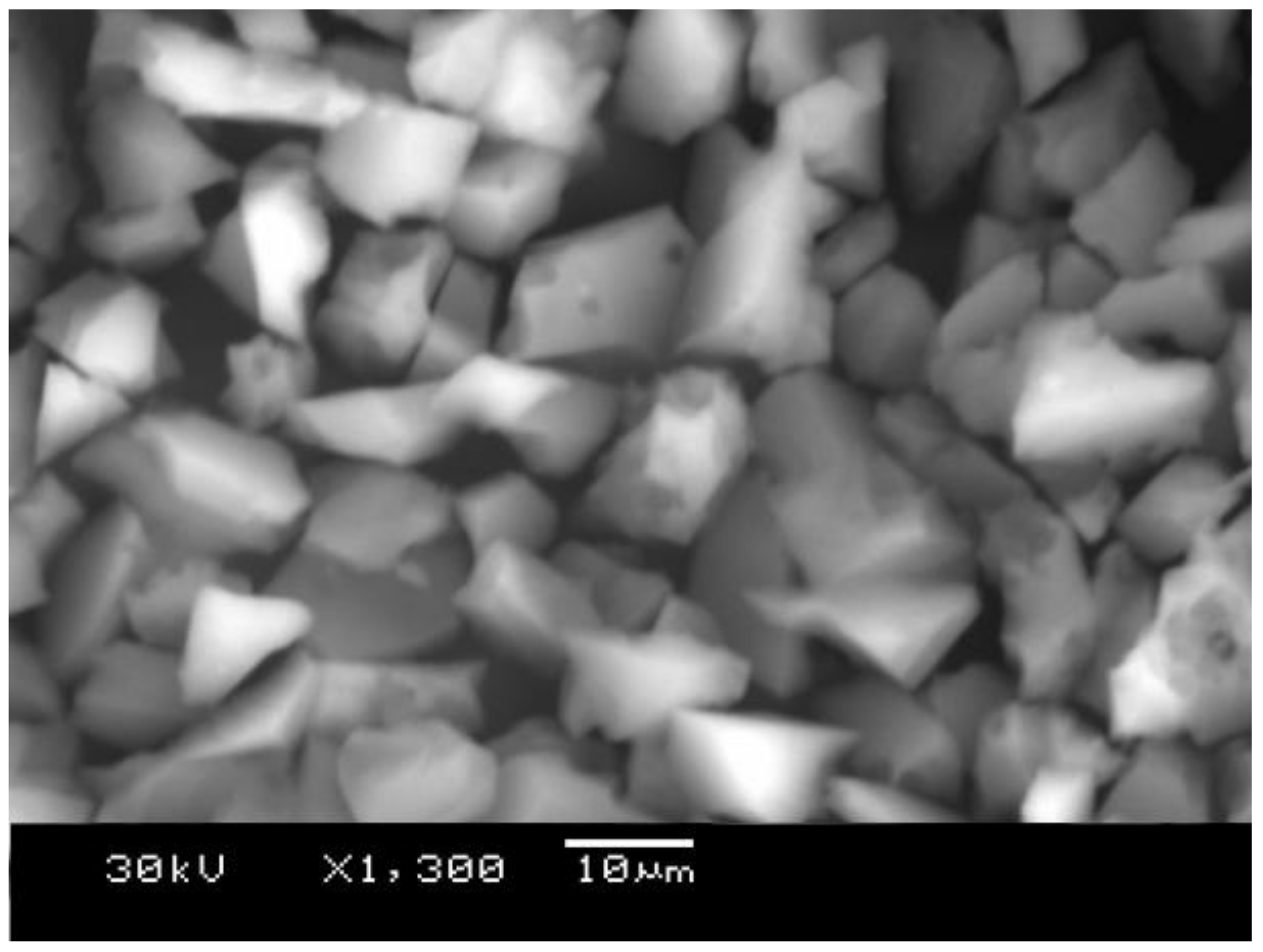

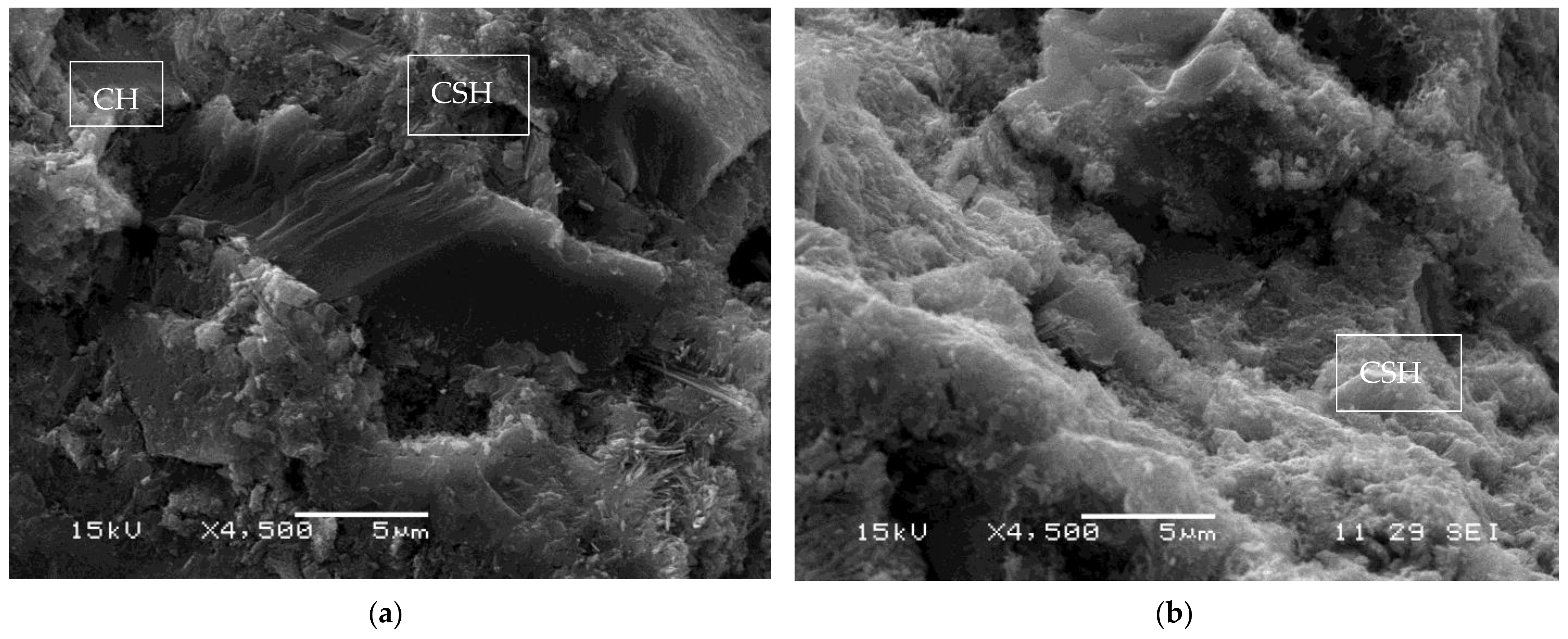

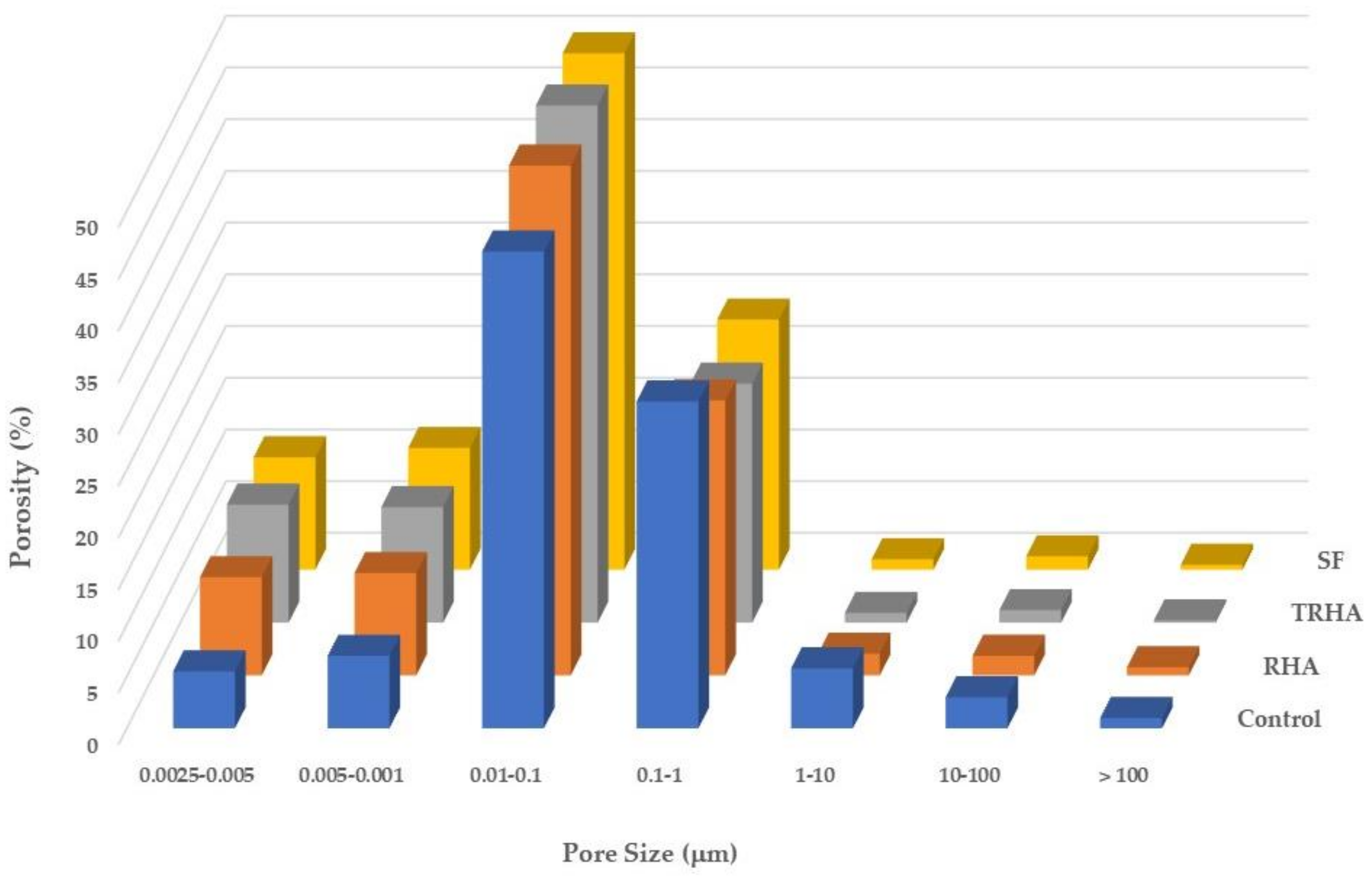
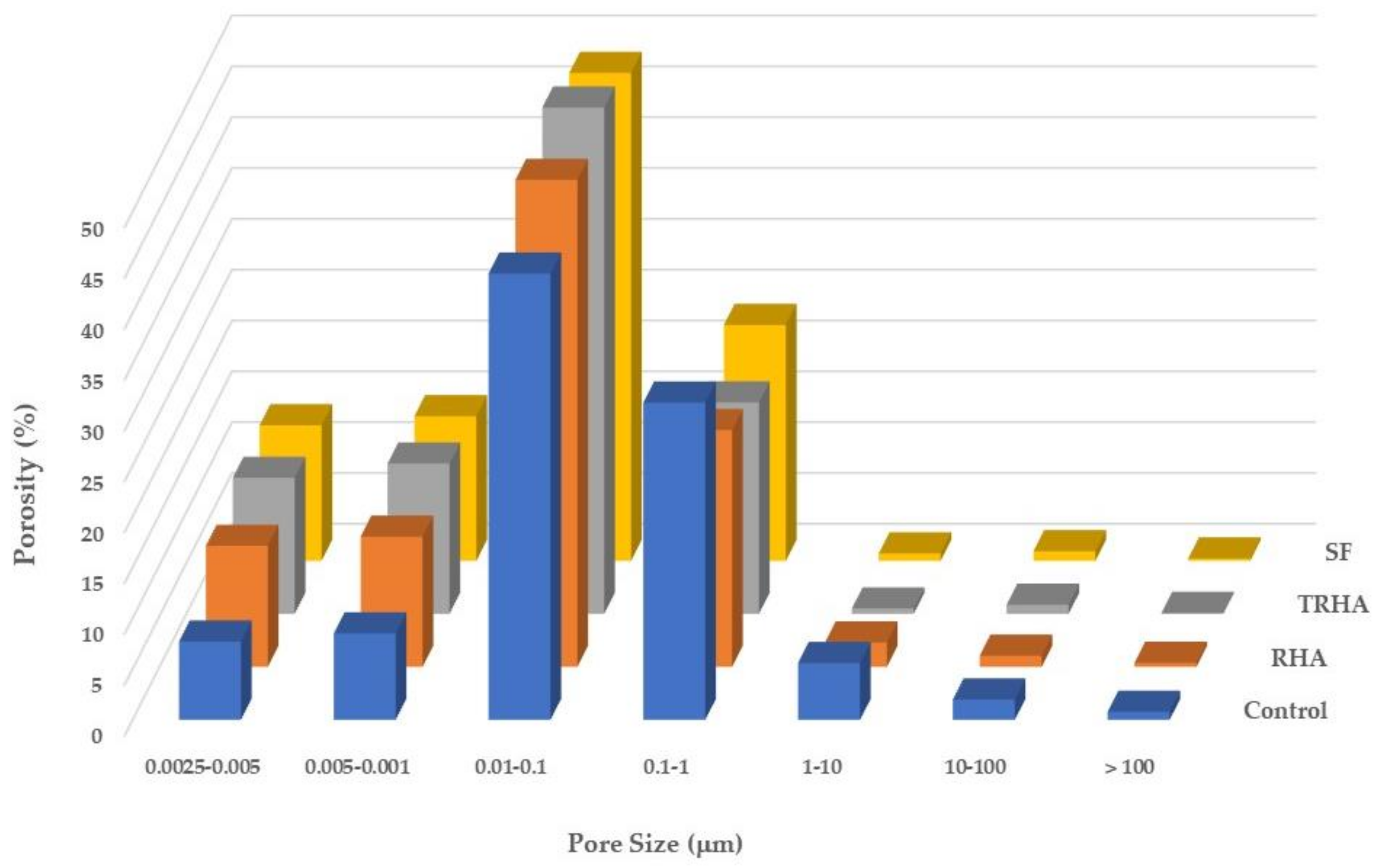


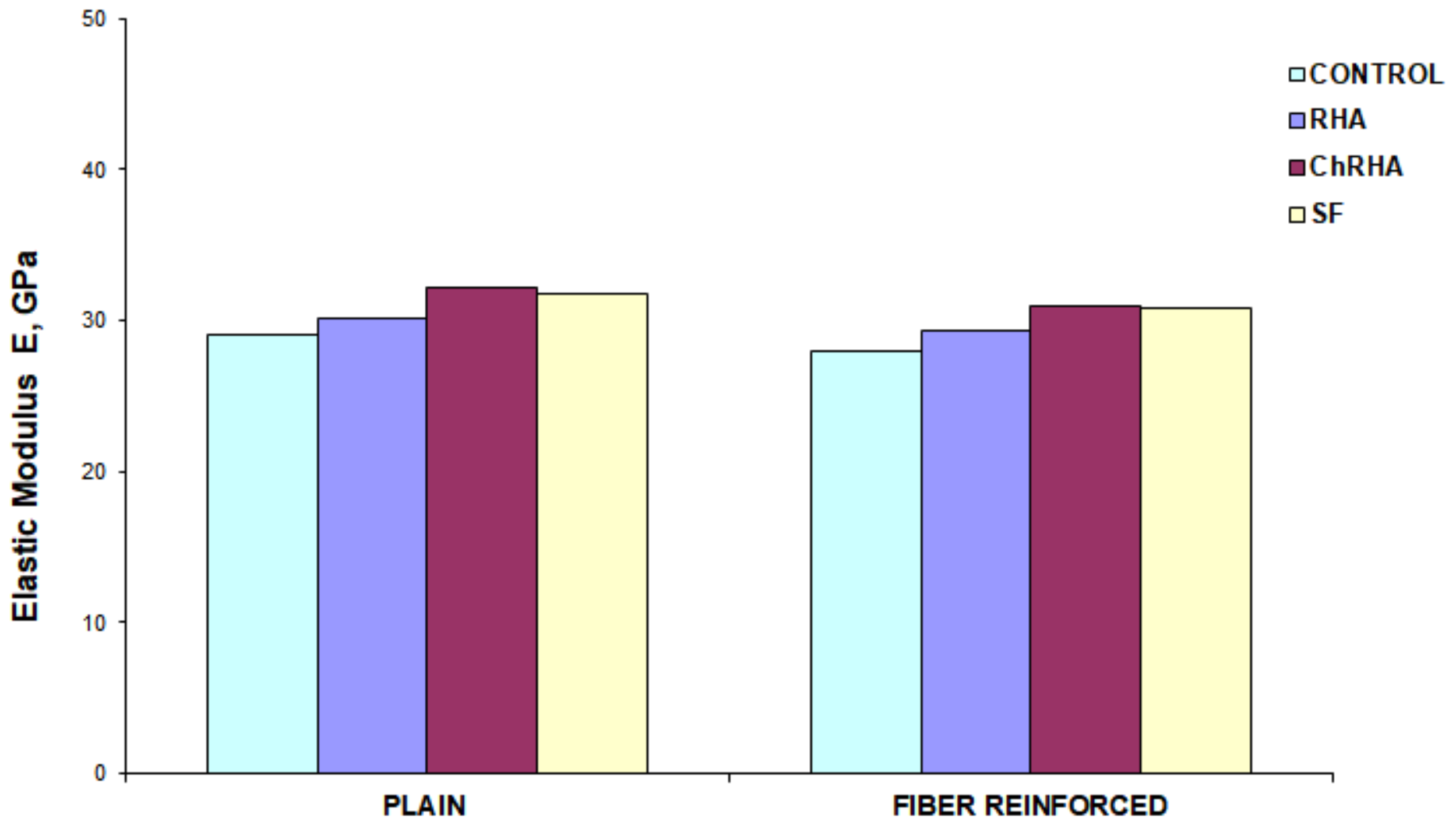

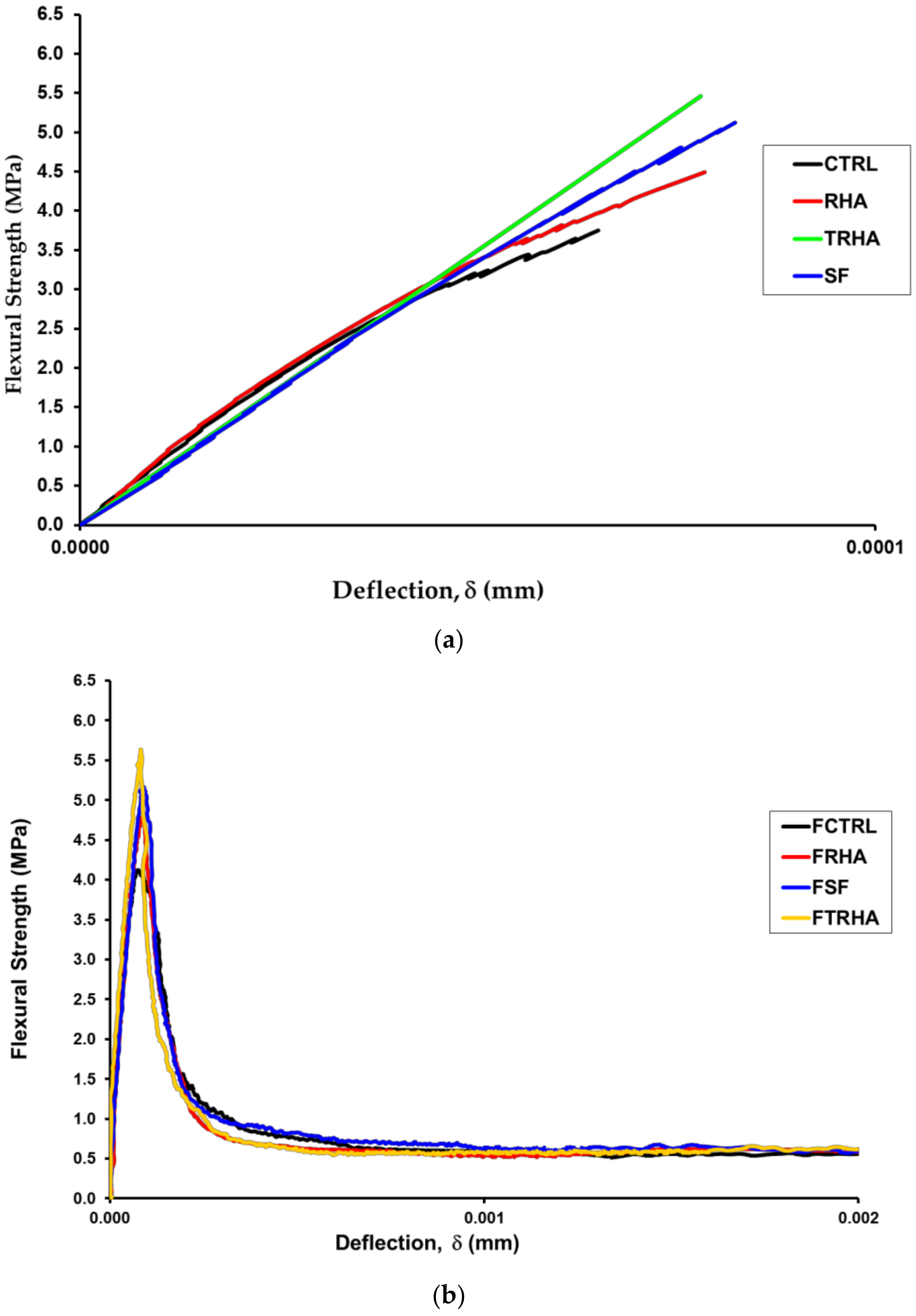

| SF | TRHA | RHA | PC | |
|---|---|---|---|---|
| SiO2 | 90 | 99 | 90 | 21.27 |
| Al2O3 | 0.46 | <0.01 | 0.68 | 4.63 |
| Fe2O3 | 4.57 | 0.13 | 0.42 | 3.96 |
| K2O | 1.69 | 0.06 | 2.8 | 0.18 |
| CaO | 0.49 | 0.49 | 1.23 | 63.05 |
| MgO | 0.68 | <0.07 | 0.35 | 1.56 |
| Na2O | 0.05 | <0.32 | <0.32 | 0.16 |
| LOI (%) | 0.54 | 0.16 | 0.13 | 2.25 |
| SF | TRHA | RHA | PC | |
|---|---|---|---|---|
| Specific gravity | 2230 | 2080 | 2160 | 3050 |
| Specific surface, (m2/Kg) | 27,000 (BET) | 274,000 (BET) | 24,000 (BET) | 377 (BLAINE) |
| Median grain size, (μm) | 0.1 | 17 | 19 | 15 |
| Color | Dark Gray | White | Pink | Gray |
| Pozzolanic Activity Index ASTM C618-ASTM C311 | 123 | 125 | 95 | - |
| Passing Percentage (%) | |||
|---|---|---|---|
| Sieve Size (mm) | Coarse Aggregate | Coarse Sand | Fine Sand |
| 19.05 | 100 | 100 | 100 |
| 12.7 | 63.6 | 100 | 100 |
| 9.51 | 31 | 96.6 | 100 |
| 4.76 | 8.4 | 81.3 | 99.9 |
| 2.38 | 5.7 | 66.2 | 97.5 |
| 1.19 | 4.1 | 49.5 | 90.6 |
| 0.595 | 3.7 | 27.9 | 79.8 |
| 0.297 | 3.3 | 9.5 | 48.7 |
| Fineness modulus | 3.63 | 1.78 | |
| Volumetric density (g/cm3) | 2.98 | 2.75 | 2.71 |
| Abs. capacity % | 1.61 | 1.64 | 2.7 |
| Specific Gravity (kg/m3) | 920 |
| Absorption, % (kg/m3) | None |
| Modulus of Elasticity | 9.5 Gpa |
| Tensile Strength | 620 Mpa |
| Melting Point | 160 °C |
| Flash Point | 590 °C |
| Chemical Composition | Polypropylene/Polyethylene Blend |
| Mix | Admixture kg/m3 | Fiber (kg/m3) | PC kg/m3 | Water L/m3 | SP % | w/cm | Aggregates kg/m3 | Slump (mm) | |||
|---|---|---|---|---|---|---|---|---|---|---|---|
| SF | RHA | TRHA | Gravel | Sand | |||||||
| Control | 0 | 0 | 0 | 0 | 440 | 198 | 0 | 0.45 | 930 | 731 | 178 |
| F-Control | 0 | 0 | 0 | 2.38 | 440 | 198 | 0.05 | 0.45 | 930.1 | 731 | 178 |
| RHA | 0 | 44 | 0 | 0 | 396 | 198 | 0.35 | 0.45 | 921 | 723.5 | 127 |
| F-RHA | 0 | 44 | 0 | 2.38 | 396 | 198 | 0.37 | 0.45 | 920.6 | 723.4 | 127 |
| TRHA | 0 | 0 | 44 | 0 | 396 | 198 | 0.38 | 0.45 | 920.1 | 722.9 | 102 |
| F-TRHA | 0 | 0 | 44 | 2.38 | 396 | 198 | 0.45 | 0.45 | 920.6 | 723.3 | 114 |
| SF | 44 | 0 | 0 | 0 | 396 | 198 | 0.20 | 0.45 | 921.8 | 724.2 | 102 |
| F-SF | 44 | 0 | 0 | 2.38 | 396 | 198 | 0.25 | 0.45 | 922.06 | 724.5 | 102 |
| Pore Size (mm) | Porosity (%) | |||||||
|---|---|---|---|---|---|---|---|---|
| Control | RHA | TRHA | SF | |||||
| 56 Days | 90 Days | 56 Days | 90 Days | 56 Days | 90 Days | 56 Days | 90 Days | |
| 0.0025–0.005 | 5.5 | 7.7 | 9.5 | 11.9 | 11.4 | 13.4 | 10.9 | 13.3 |
| 0.005–0.01 | 7.0 | 8.5 | 9.9 | 12.8 | 11.2 | 14.8 | 11.8 | 14.2 |
| 0.01–0.1 | 46.1 | 43.9 | 49.3 | 47.9 | 52.0 | 49.8 | 49.9 | 48.0 |
| 0.1–1 | 31.6 | 31.2 | 26.6 | 23.3 | 23.1 | 20.8 | 24.2 | 23.2 |
| 1–10 | 5.8 | 5.6 | 2.1 | 2.4 | 0.9 | 0.5 | 1.0 | 0.7 |
| 10–100 | 3.0 | 2.0 | 1.9 | 1.1 | 1.2 | 0.9 | 1.3 | 1.0 |
| >100 | 1 | 0.8 | 0.8 | 0.4 | 0.22 | 0.09 | 0.48 | 0.23 |
| Mix | Compressive Strength, MPa | ||||
|---|---|---|---|---|---|
| 7 | 28 | 56 | 90 | 180 | |
| CONTROL | 31.5 | 42.2 | 48.8 | 51.1 | 51.5 |
| SF | 35.3 | 47.6 | 54.7 | 55.8 | 56.6 |
| RHA | 32.9 | 43.8 | 49.2 | 52.1 | 52.6 |
| TRHA | 38.6 | 49.2 | 55.4 | 56.9 | 58.0 |
| F-CONTROL | 29.9 | 40.0 | 46.3 | 48.9 | 49.5 |
| F-SF | 33.9 | 46.4 | 52.0 | 54.1 | 55.3 |
| F-RHA | 32.6 | 41.4 | 47.0 | 49.4 | 50.3 |
| F-TRHA | 37.8 | 48.2 | 54.4 | 55.1 | 56.5 |
| MIX | In the First Crack | I5 | I10 | I20 | I30 | I60 | I10/I5 | I20/I10 | I30/I20 | I60/I30 | |
|---|---|---|---|---|---|---|---|---|---|---|---|
| Flexural Strength, MPa | Deflection, mm | ||||||||||
| FSF | 5.27 | 0.0000856 | 2.51 | 3.28 | 4.47 | 5.52 | 8.51 | 1.31 | 1.36 | 1.23 | 1.54 |
| FTRHA | 5.69 | 0.0000820 | 2.12 | 2.65 | 3.45 | 4.26 | 6.84 | 1.25 | 1.30 | 1.24 | 1.60 |
| FCTRL | 4.13 | 0.0000641 | 3.34 | 4.48 | 5.95 | 7.17 | 10.88 | 1.34 | 1.33 | 1.21 | 1.52 |
| F-RHA | 4.81 | 0.0000861 | 2.44 | 3.05 | 4.06 | 5.00 | 7.96 | 1.25 | 1.33 | 1.23 | 1.59 |
| Mix | Adjusted Transferred Load (Coulombs) | Resistivity ρ × 10−3 (ohms·cm) | |
|---|---|---|---|
| CTRL | 3529 | Moderate | 6.25 |
| FCTRL | 4189 | High | 4.92 |
| RHA | 1413 | Low | 14.9 |
| F-RHA | 1428 | Low | 15.0 |
| SF | 970 | Very low | 22.0 |
| FSF | 1017 | Low | 20.4 |
| TRHA | 960 | Very low | 22.2 |
| FTRHA | 1005 | Low | 20.8 |
| Mix | Depth of Carbonation (cm) |
|---|---|
| CONTROL | 0.10 |
| FCONTROL | 0.35 |
| RHA | 0.20 |
| F-RHA | 0.30 |
| TRHA | 0.20 |
| FTRHA | 0.24 |
| SF | 0.15 |
| FSF | 0.20 |
Disclaimer/Publisher’s Note: The statements, opinions and data contained in all publications are solely those of the individual author(s) and contributor(s) and not of MDPI and/or the editor(s). MDPI and/or the editor(s) disclaim responsibility for any injury to people or property resulting from any ideas, methods, instructions or products referred to in the content. |
© 2023 by the authors. Licensee MDPI, Basel, Switzerland. This article is an open access article distributed under the terms and conditions of the Creative Commons Attribution (CC BY) license (https://creativecommons.org/licenses/by/4.0/).
Share and Cite
Salas Montoya, A.; Chung, C.-W.; Kim, J.-H. High Performance Concretes with Highly Reactive Rice Husk Ash and Silica Fume. Materials 2023, 16, 3903. https://doi.org/10.3390/ma16113903
Salas Montoya A, Chung C-W, Kim J-H. High Performance Concretes with Highly Reactive Rice Husk Ash and Silica Fume. Materials. 2023; 16(11):3903. https://doi.org/10.3390/ma16113903
Chicago/Turabian StyleSalas Montoya, Andres, Chul-Woo Chung, and Ji-Hyun Kim. 2023. "High Performance Concretes with Highly Reactive Rice Husk Ash and Silica Fume" Materials 16, no. 11: 3903. https://doi.org/10.3390/ma16113903
APA StyleSalas Montoya, A., Chung, C.-W., & Kim, J.-H. (2023). High Performance Concretes with Highly Reactive Rice Husk Ash and Silica Fume. Materials, 16(11), 3903. https://doi.org/10.3390/ma16113903







